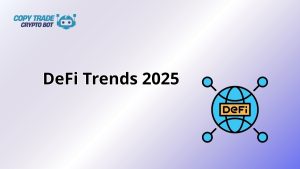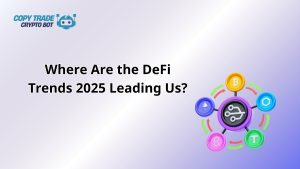Table of Contents
- 1 The Rise of DeFi Trends 2025
- 2 Key DeFi Trends 2025
- 2.1 Layer 2 Scaling Solutions Are Going Mainstream
- 2.2 Tokenized Real-World Assets (RWAs) Gain Momentum
- 2.3 AI Integration is Revolutionizing DeFi Infrastructure
- 2.4 Interoperability and Cross-Chain Liquidity
- 2.5 Decentralized Identity (DID) and Reputation Systems
- 2.6 DeFi Regulation: Clarity and Adaptation
- 2.7 DAO Evolution and On-Chain Governance 2.0
- 2.8 DeFi Insurance and Risk Management Tools
- 2.9 Yield Aggregation and Sustainable Returns
- 2.10 Gamified DeFi and Onboarding Tools
- 3 Where Are the DeFi Trends 2025 Leading Us?
The Rise of DeFi Trends 2025

Decentralized Finance (DeFi) has rapidly evolved from an experimental frontier to a transformative force within the broader financial ecosystem. As we approach 2025, the DeFi sector is experiencing a new wave of innovation, reshaped by scalability improvements, regulatory developments, AI integration, and more. In this article, we explore the top DeFi trends 2025 that are set to redefine how we think about money, governance, and access to financial tools.
Whether you’re an investor, developer, or enthusiast, understanding these trends can help you navigate the DeFi landscape with confidence and foresight.
Key DeFi Trends 2025
Layer 2 Scaling Solutions Are Going Mainstream
Scalability has always been a pressing challenge in decentralized finance. In 2025, Layer 2 (L2) solutions like Arbitrum, Optimism, zkSync, and Starknet are reaching mass adoption. These L2 protocols provide faster, cheaper transactions while leveraging the security of Ethereum’s mainnet.
The trend is being driven by:
- Reduced gas fees: Transaction costs on L2 are significantly lower than on L1 networks.
- Higher throughput: Dapps can handle more users without congestion.
- Ecosystem growth: Major DeFi platforms like Uniswap, Aave, and Curve are actively deploying on L2.
This trend enables smaller users to participate in DeFi without facing prohibitive costs, increasing global access and engagement.
Tokenized Real-World Assets (RWAs) Gain Momentum
One of the most disruptive DeFi trends 2025 is the tokenization of real-world assets. DeFi platforms are increasingly bridging the gap between on-chain and off-chain assets by tokenizing things like:
- Real estate
- Treasury bills and government bonds
- Commodities like gold or oil
- Revenue streams and invoices
Projects such as Centrifuge, Maple Finance, and Goldfinch are leading the charge. BlackRock’s involvement in tokenized assets further validates the institutional interest.
These tokenized RWAs provide:
- On-chain liquidity for traditionally illiquid markets
- Lower barriers to entry for investors globally
- Transparent, programmable ownership
By 2025, RWAs are no longer experimental—they’re foundational to DeFi’s evolving architecture.
AI Integration is Revolutionizing DeFi Infrastructure
Artificial Intelligence (AI) is no longer limited to image generators or chatbots—it’s becoming a powerful tool in DeFi protocols. AI integration in DeFi is shaping the future of:
- Algorithmic trading strategies
- Credit scoring for undercollateralized loans
- Fraud detection and smart contract auditing
- Personalized DeFi portfolio recommendations
DeFi platforms like Gensyn, Fetch.ai, and Numerai are combining blockchain transparency with AI’s analytical capabilities. By 2025, AI-powered DeFi protocols can dynamically adjust yields, optimize liquidity provision, and even help DAOs make smarter decisions.
This synergy between AI and DeFi unlocks deeper automation, smarter risk management, and more intuitive financial tools.
Interoperability and Cross-Chain Liquidity
A major challenge for DeFi in the past has been fragmentation. Users often get stuck on one chain, losing access to liquidity and services elsewhere. Cross-chain interoperability is a leading DeFi trends 2025 aimed at solving this.
Technologies making this possible:
- Bridges like Wormhole, LayerZero, and Axelar
- Cross-chain DEXs like ThorChain and SushiXSwap
- Modular blockchains like Cosmos and Polkadot
These solutions allow DeFi users to:
- Swap tokens across chains seamlessly
- Use assets as collateral on different chains
- Access multi-chain DeFi tools from a unified interface
As a result, liquidity becomes more fluid, efficient, and global—ushering in the next era of composable finance.
Decentralized Identity (DID) and Reputation Systems
A key pain point in DeFi has always been anonymity, which limits undercollateralized lending and broader user profiling. Decentralized Identity (DID) solutions are rapidly emerging as a fix.
DID protocols like Polygon ID, Lens Protocol, and Spruce enable users to:
- Prove credentials without revealing identity
- Build verifiable on-chain reputation
- Access personalized financial services
In 2025, DID plays a central role in:
- DeFi credit systems
- KYC/AML compliance without centralized data storage
- DAO voting power tied to verified participation
This trend aligns privacy with functionality, opening doors for deeper integrations between DeFi and real-world users.
DeFi Regulation: Clarity and Adaptation
Regulatory clarity is one of the most critical DeFi trends 2025. Rather than stifling innovation, new frameworks are encouraging responsible development.
Key movements include:
- The EU’s MiCA framework offering guidance for crypto service providers
- The U.S. beginning to distinguish between decentralized protocols and custodial entities
- Asian markets like Hong Kong and Singapore creating “DeFi sandboxes”
This wave of regulation impacts DeFi by:
- Promoting institutional adoption
- Encouraging transparency and compliance
- Filtering out scams and bad actors
Smart DeFi protocols are adapting with built-in compliance tools and governance structures that work within legal boundaries—positioning themselves for sustainable growth.
DAO Evolution and On-Chain Governance 2.0
Decentralized Autonomous Organizations (DAOs) have grown from rudimentary governance experiments to sophisticated on-chain entities. In 2025, DAOs are evolving in multiple directions:
- Modular DAO frameworks like Aragon OSx and DAOstack
- Delegated governance with incentive-aligned stewards
- On-chain voting tied to identity and activity, not just token holdings
DAOs are now managing:
- Billion-dollar treasuries
- Multi-protocol strategies
- Real-world partnerships
As DeFi matures, DAOs are proving to be agile, transparent governance models. Their success is driving a broader move toward community-led protocol development, further embedding decentralization as a core value in 2025.
DeFi Insurance and Risk Management Tools
With the growing value locked in DeFi protocols, insurance and risk mitigation are becoming vital pillars in the evolving landscape of DeFi trends 2025. Key 2025 developments include:
- Parametric insurance protocols like Nexus Mutual, InsurAce, and Risk Harbor
- On-chain coverage markets with transparent policies
- Automated risk scoring powered by AI and decentralized oracles
These tools give users protection against:
- Smart contract exploits
- Liquidity crashes
- Governance attacks
As the ecosystem expands, risk management becomes a core utility for serious users and institutions. This critical aspect of DeFi trends 2025 will further legitimize decentralized finance as a parallel financial infrastructure.
Yield Aggregation and Sustainable Returns
DeFi initially attracted users with unsustainable, high-yield farming. In 2025, yield optimization is becoming more intelligent and long-term focused. The evolution includes:
- Auto-compounding vaults that optimize across chains
- Real yield models tied to protocol fees, not emissions
- Treasury management DAOs that rebalance exposure automatically
Protocols like Yearn Finance, Beefy, and Idle Finance are refining these strategies. The trend is about sustainability—delivering transparent, consistent returns rather than speculative bursts.
In 2025, smart users seek risk-adjusted returns over hype. This demand is shaping how DeFi products are built and used.
Gamified DeFi and Onboarding Tools
Onboarding new users has always been a challenge in DeFi. Among the most exciting DeFi trends 2025, gamified interfaces and social DeFi experiences are becoming a dominant on-ramp for the next wave of users.
Examples include:
- Fantasy trading apps using real DeFi data
- Social trading platforms built on smart contracts
- Reward-based onboarding journeys powered by NFTs and quests
Projects like Galxe, Layer3, and Rabbithole make learning DeFi interactive. These tools align perfectly with DeFi trends 2025 by driving higher user engagement, reducing churn, and helping turn first-timers into long-term DeFi users.
Where Are the DeFi Trends 2025 Leading Us?

The DeFi trends 2025 point to a maturing ecosystem—one that balances decentralization with usability, innovation with security, and openness with compliance. As we move further into the year, the lines between traditional finance and DeFi will continue to blur, creating a hybrid landscape of programmable money and decentralized trust.
Are you ready to position yourself at the forefront of decentralized finance? Dive deeper into the protocols, communities, and tools that are shaping the next chapter of global finance.
